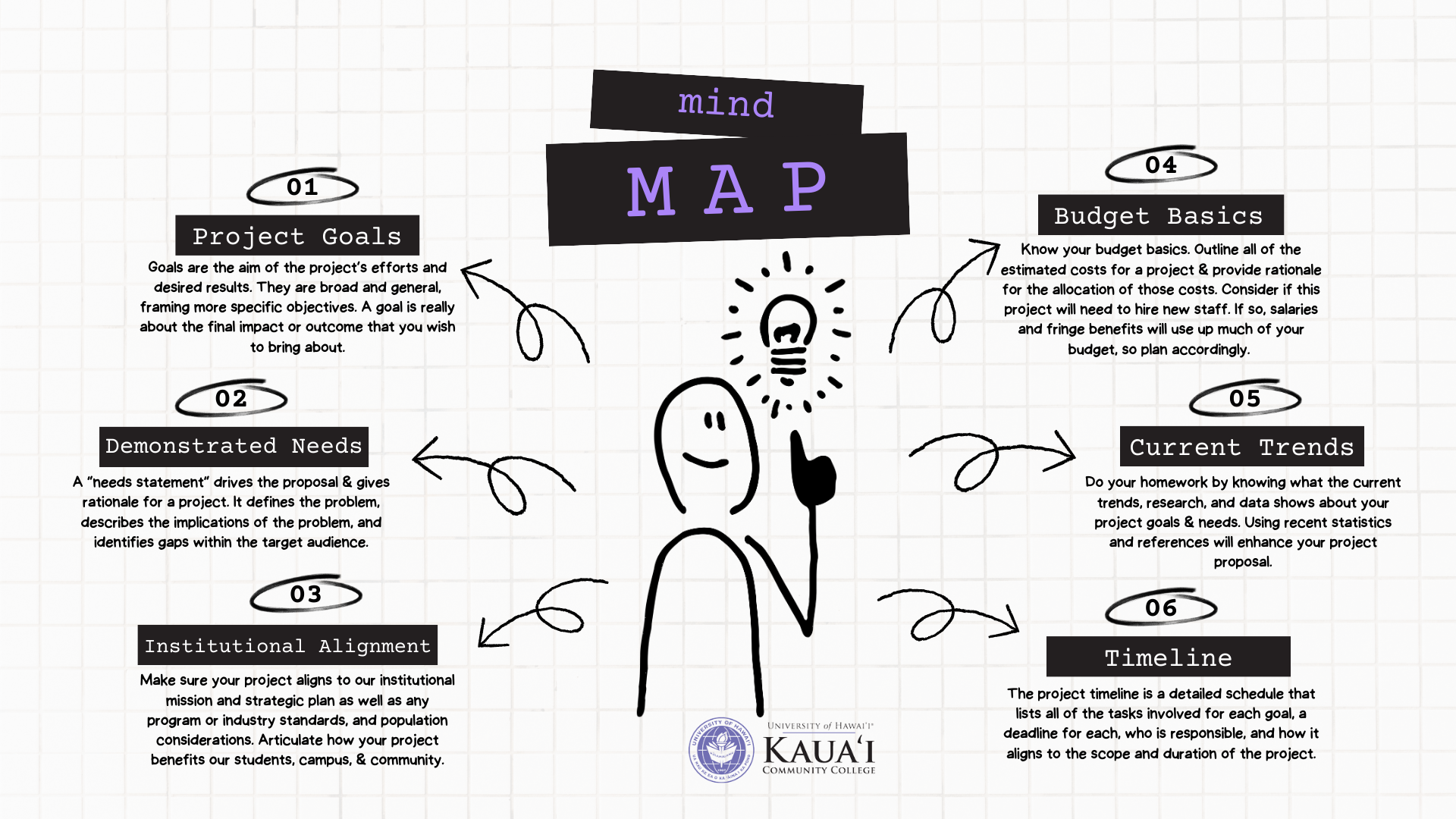
Project Goals
Goals are the aim of the project’s efforts and desired results. They are broad and general, framing more specific objectives. A goal is really about the final impact or outcome that you wish to bring about.
Example:
- Increase enrollment and success for students in area high schools by creating an articulated sequence of Early College courses to provide clear pathways into postsecondary education at KauCC. (Source: Title III-Kukulu Ae)
Demonstrating Needs
A “needs statement” drives the proposal & gives rationale for a project. It defines the problem, describes the implications of the problem, and identifies gaps within the target audience. A statement of need for a grant describes the specific public or community needs an organization or project will address. An effective needs statement conveys urgency, demonstrates how critical needs are currently unmet or underserved, and reveals the real-world impact of unmet needs.
Example:
- Student enrollment, especially for students entering directly from local high schools, has decreased 7% over the past two years (35% from 42%). (Source: Title III-Kukulu Ae)
Institutional Alignment
Make sure your project aligns to our institutional mission and strategic plan as well as any program or industry standards, and population considerations. Articulate how your project benefits our students, campus, & community.
Example:
- Strategic Plan Priority 2018-19 (Enrollment): Direct high school graduate enrollment has been a strategic priority of the KauCC that has not been met. (Source: Title III-Kukulu Ae)
Budget Basics
Know your budget basics. Given the project goals and scope being considered, what and how much money is needed to fund this idea. If you have identified an RFP, what is the budget floor (minimum) and ceiling (maximum) allowed for the funding opportunity? Does the proposed budget scope match your needs?
Outline all of the estimated costs for a project & provide a rationale for the allocation of those costs. Consider if this project will need to hire new staff. If so, salaries and fringe benefits will use up much of your budget, so plan accordingly.
Example
|
|
||||
|
|
|
|
|
|
|
|
|
|
|
|
|
|
|
|
|
|
|
|
|
|
|
|
|
|
|
|
|
|
|
|
|
|
|
|
|
|
|
|
|
|
|
|
|
|
|
|
|
|
|
|
|
|
|
|
|
|
|
|
*Our GDO can assist you with beginning this process.
Current Trends
Do your homework by knowing what the current trends, research, and data shows about your project goals & needs. Using recent statistics and references will enhance your project proposal. Industry or Program area standards could be relevant to your proposal as well.
Data Dive:
- IRAPO (UH Institutional Research, Analysis & Planning Office) provides current and historical data across the UH System that can be disaggregated by campus, ethnicity, program, and selected characteristics.
- Google Scholar is a search engine that allows users to search for academic resources and scholarly literature.
- Kauai CC Library Services website homepage has a search bar to identify books, articles, films, and more resources available right here and through UH Manoa.
- Census
- DOE
- P-20 (DXP)
Example:
- 70.6% of enrolled students at Kauai CC in the Fall 2023 semester are 21 years of age or younger.
Timeline
The project timeline is a detailed schedule that lists all of the tasks involved for each goal, a deadline for each, who is responsible, and how it aligns to the scope and duration of the project.
Kaua‘i CC Grant Development Policy:
- Purpose: The purpose of this policy is to provide general information and guidance to faculty and staff regarding the development, submission, and management of grants.
|
|
|
|
|
|
|
|
|
|
|
|
|
|
|
|||||
|
|
|
|
|
|||||
|
|
|
|
|
|
||||
|
|
|
|
|
|
||||
|
|
|
|
|
|
|
|||
|
|
|
|
|
|
||||
|
|
|
|
|
|
|
|||
|
|
|
|
|
|
|
|||
|
|
|
|
|
Training
Take advantage of the Funding Agency or Sponsor resources.
- Many funding agencies hold informational sessions as Webinars or in-person. The webinars are usually recorded and archived, so look to see if there was a webinar on file with the agency that might be helpful. In addition, some agencies compile a Frequently Asked Questions resource for reference.
- These types of information sessions are a great way to learn of funders' goals and upcoming opportunities, and ask questions.
- It is also a great way to meet others (even online) who could be potential collaborators and to get to know the managers for the agency programs.
Ask Questions
- Each grant Request for Proposals (RFP) identifies the manager(s) for each solicitation, and these people are available to answer questions about the RFP. Email usually works the best, but phone contact can be helpful.
- Use Email for specific Q&A since this gives you an answer in writing to your questions.
- Take advantage of your in-house resources, and your partners' expertise.
- Don't be afraid to ask questions and get clarification!
